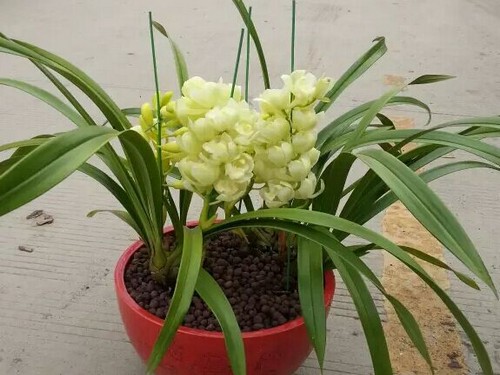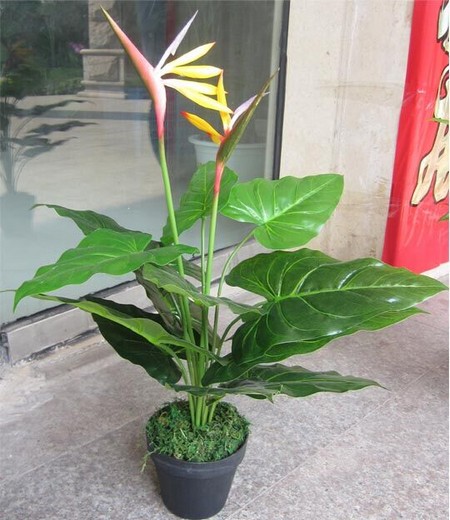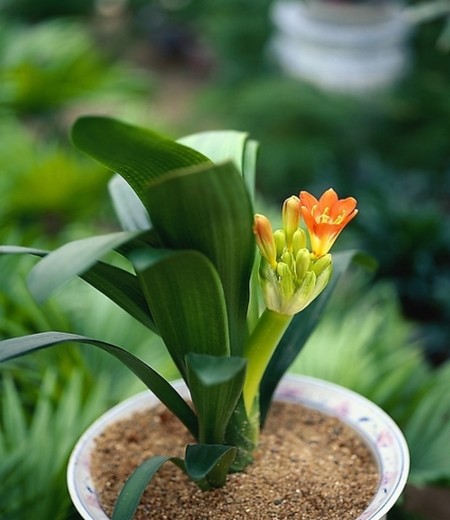How to raise Cymbidium in potted plants
The leaves of Cymbidium are slender, plump and gorgeous, with large flowers and standing tall. Each plant often blossoms two or three branches, in full bloom, such as brocade heap embroidery, reflect each other, magnificent, extraordinary momentum. Large plants are mostly used for cut flower cultivation, small and medium-sized plants are mostly used as potted plants, suitable for decorating guest halls, windowsills and other places. So, how should Cymbidium be raised?

Temperature: the suitable temperature for the growth of Cymbidium is 15-27 ℃, the overwintering temperature should not be lower than 10 ℃, and the summer temperature should not be higher than 29.5 ℃. During the period of flower bud differentiation, that is, summer and autumn, there must be obvious temperature difference between day and night to make the flower bud differentiate. When the flower bud has germinated, the temperature should not exceed 14 ℃ at night, otherwise it is easy to wither the flower bud earlier.
Selection of substrate and basin: it is appropriate to choose a long barrel basin with porous bottom and four walls, the cultivation substrate should choose bark blocks or fern roots with good air permeability and water permeability, and charcoal, ceramsite and other things should be added in the lower part of the basin to facilitate drainage.
Fertilization and watering: it is not suitable to water immediately after ramet planting. If it is found to be dry, water can be sprayed to the leaf surface and basin surface to prevent the leaves from drying up, falling off and pseudo-bulbs from shrinking. Wait for new buds and roots to grow before watering. Watering during cultivation should depend on the weather and dry and wet conditions. Adequate water should be supplied to the ministry during the vigorous growth period, and timely watering should be needed in the dry and hot seasons. When the temperature is low in winter, the watering times can be reduced. The pH of watering water should be 6.5. Cymbidium prefers fertilizer, and compound fertilizer with a concentration of 0.1% Mel 0.2% nitrogen fertilizer should be applied once a week after new buds grow in spring. Or rotten thin cake fat and water. In the bud stage, the available phosphorus and potassium fertilizer should be applied in advance.
Lighting and ventilation: avoid direct sunlight, need sufficient scattered light, and shade about 50% under strong summer light. There can be a little more sunshine in autumn-conducive to flower bud formation and overwintering. In winter, greenhouse light can be placed in areas with strong sunshine and high temperature in the south of China, which should be cultivated in the shade all the year round. In order to facilitate ventilation, overhead placement should not be too dense.
As a rule, when the plant is too large, the plant should be changed and put on the pot in order to promote growth and flowering. The time to change the basin should be carried out after flowering or when the new buds are just sprouting in early spring. Before changing the basin, pour the plant out of the old basin, cut off the rotten roots and yellow leaves, remove the old matrix, and then put a layer of broken tiles or bricks at the bottom of the new basin to facilitate drainage and ventilation, put the plant into the basin, fill in the new substrate, and pour water through hand compaction.
The loose and breathable humus soil or slightly acidic mountain soil made from bamboo leaves in the bamboo forest should be exposed to the sun in summer for 5 ~ 6 days before it can be used. When the seedlings are planted in the center of the basin, the roots are stretched and distributed around the basin, and then fill the basin with soil. It is not suitable to water immediately after planting (if it is found to be dry, water can be sprayed to the basin surface to prevent false bulbs from shrinking). Place the bright scattered light in the room. Need to shade about 50% under the strong light in summer, avoid direct sunlight. There can be more sunshine in autumn and a sunny place indoors in winter.
The watering asked during the growing period, spring is the season of exuberant growth, sufficient water should be supplied, and the basin soil should be kept moist and high air humidity. Spray water on the ground and around the basin, spray on the leaves. Timely watering is needed in summer. The basin soil during flower bud formation and bud formation should be dry and avoid dampness. Autumn is in the relative dormant period of flower bud formation. Watering should be reduced. In order to facilitate flower bud differentiation.
In winter, when the flower bud is elongated, it is necessary to have a certain amount of water supply and a certain amount of humidity in the air, otherwise, the flower buds are easy to wither and yellow. Can't blossom. It should be noted that when watering, do not pour water on leaf axils and flowers, and prevent stagnant water in the basin soil; after sprouting in spring, apply 0.1%-0.2% nitrogen-based compound fertilizer or rotten thin cake fertilizer once every 7~l0 day. When flower buds were divided into flowers and buds, liquid fertilizer dominated by phosphorus and potassium was applied every 7 days, and fertilization was stopped in midsummer and dormant periods. The temperature is usually 25 ℃ during the day and 10 ℃ at night. If the night temperature is higher than 20 ℃, it will wither the buds or affect flowering. The room temperature in winter should not be lower than 10 ℃.
Time: 2019-06-01 Click:
- Prev

Cultivation methods and precautions of potted Stagelaria
St. regina is a flower with ornamental value. St. regina blossoms from September to June of the following year. The shape of the flower is like a crane looking up from afar. The shape is beautiful. It is loved by many friends. St. regina can not only be planted as a potted plant, but also a good helper for home decoration.
- Next

How to raise a gentleman orchid to blossom
How to raise a gentleman orchid to blossom? For this problem, it can be said that Cymbidium culture enthusiasts are very concerned about it. We raise magnolia not only to watch the leaves, but also to watch the flowers. So, how does the gentleman orchid blossom the most beautiful? in fact, it is also very simple, that is, in the daily maintenance.
Related
- Fuxing push coffee new agricultural production and marketing class: lack of small-scale processing plants
- Jujube rice field leisure farm deep ploughing Yilan for five years to create a space for organic food and play
- Nongyu Farm-A trial of organic papaya for brave women with advanced technology
- Four points for attention in the prevention and control of diseases and insect pests of edible fungi
- How to add nutrient solution to Edible Fungi
- Is there any good way to control edible fungus mites?
- Open Inoculation Technology of Edible Fungi
- Is there any clever way to use fertilizer for edible fungus in winter?
- What agents are used to kill the pathogens of edible fungi in the mushroom shed?
- Rapid drying of Edible Fungi

